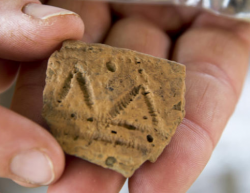INSTITUT SUPERIEUR D'ANTHROPOLOGIE
INSTITUTE OF ANTHROPOLOGY
ONLINE COURSES / COURS A DISTANCE
SUMMER TERM : JULY 2016
REGISTER NOW
INDE –  Kunan - Archaeologists have discovered a rare statue dating back to the Karkota era (600 AD- 800 AD) from a play field in Kunan village of Bandipora district in North Kashmir. Measuring 5.5 ft in length and 15 inches in width, the rare memorial stone slab was discovered during an excavation undertaken at Kunan village to remove the debris from the local playing ground. Preliminary investigations have revealed that the sculpture probably dates back to the 1400-year-old Karkota era (600 AD-800). The sculpture is a first find of its kind when such a motif has made its appearance in such a magnificent way. The face of the memorial stone is in three panels depicting few crude human and animal images. The central panel carries an interesting image of a standing turban headed human figure holding bow and arrow to its left while the motif of dragger fixed on his waist towards its left,
Kunan - Archaeologists have discovered a rare statue dating back to the Karkota era (600 AD- 800 AD) from a play field in Kunan village of Bandipora district in North Kashmir. Measuring 5.5 ft in length and 15 inches in width, the rare memorial stone slab was discovered during an excavation undertaken at Kunan village to remove the debris from the local playing ground. Preliminary investigations have revealed that the sculpture probably dates back to the 1400-year-old Karkota era (600 AD-800). The sculpture is a first find of its kind when such a motif has made its appearance in such a magnificent way. The face of the memorial stone is in three panels depicting few crude human and animal images. The central panel carries an interesting image of a standing turban headed human figure holding bow and arrow to its left while the motif of dragger fixed on his waist towards its left,
http://www.dnaindia.com/india/report-statue-dating-back-to-1400-years-found-in-kashmir-2219731
USA –  Jug Bay - For the past 11 days, archaeologists from across the region have flocked to the shore of the Patuxent River at Jug Bay Wetlands Sanctuary for a dig-a-thon, uncovering more evidence of a large indigenous settlement stretching for 2 miles along the river and thousands of years into our past. Last year, more than 625 "test pits" revealed the widespread area full of artifacts seemingly tied to the discoveries at Pig Point, a mile upstream, where evidence of a vast sacred burial center have been found. Ninety-eight percent of the test pits revealed evidence of cultural artifacts
Jug Bay - For the past 11 days, archaeologists from across the region have flocked to the shore of the Patuxent River at Jug Bay Wetlands Sanctuary for a dig-a-thon, uncovering more evidence of a large indigenous settlement stretching for 2 miles along the river and thousands of years into our past. Last year, more than 625 "test pits" revealed the widespread area full of artifacts seemingly tied to the discoveries at Pig Point, a mile upstream, where evidence of a vast sacred burial center have been found. Ninety-eight percent of the test pits revealed evidence of cultural artifacts
http://www.capitalgazette.com/news/environment/ph-ac-cn-point-dig-0605-20160605-story.html
ROYAUME UNI - Clanfield - An project which could shed new light on the district’s Bronze and Iron Age past is being jeopardised by ‘night hawks’. Archaeologists are keeping their fingers crossed as a team, led by Chris Healey, has begun a dig at a semi-rural site near Clanfield. Fragments of pottery, flint tools and bone have been found in the area, while there is evidence to suggest the plot may have been used for ironworking. But the Catherington Archaeology Group (CAG) may never know the full story as metal detector enthusiasts have made the most of the team’s handiwork.
http://www.petersfieldpost.co.uk/article.cfm?id=105413&headline=Archaeologists%20frustrated%20as%20%27Night%20hawks%27%20swoop%20on%20East%20Hampshire%20dig§ionIs=news&searchyear=2016
FRANCE –  Angers - Une équipe d'archéologues est à l'oeuvre devant la cathédrale Saint-Maurice, à Angers. Leurs recherches serviront à la future restauration du portail de l'édifice. En creusant sous les pavés devant l'édifice religieux, les archéologues cherchent plus précisément à analyser les structures de l'ancienne galerie, qui protégeait l’entrée de l'édifice du XIIIe siècle jusqu'en 1807. Au cours de leur mission, outre les fondations recherchées, les archéologues sont déjà tombés sur deux sarcophages, datant probablement de la fin du Moyen-Âge.
Angers - Une équipe d'archéologues est à l'oeuvre devant la cathédrale Saint-Maurice, à Angers. Leurs recherches serviront à la future restauration du portail de l'édifice. En creusant sous les pavés devant l'édifice religieux, les archéologues cherchent plus précisément à analyser les structures de l'ancienne galerie, qui protégeait l’entrée de l'édifice du XIIIe siècle jusqu'en 1807. Au cours de leur mission, outre les fondations recherchées, les archéologues sont déjà tombés sur deux sarcophages, datant probablement de la fin du Moyen-Âge.
http://www.ouest-france.fr/pays-de-la-loire/angers-49000/angers-un-chantier-archeologique-au-pied-de-la-cathedrale-4272964
ROUMANIE - Ploiesti - Archaeologists from the Prahova County Museum of History discovered a 5000-year old tomb on Tuesday, on a field outside Ploiesti. The archaeologists found the main tomb of a tumulus that apparently belonged to an important person from a group of Nomads. The skeleton was found wearing a necklace made of copper and kaolin, with a “glasses” pendant. According to the archaeologists, such discoveries are rare.“You don’t make such a discovery every day. It is the third such necklace found in Prahova county. They are extremely rare in the rest of Romania, especially in tombs that are over 5000 years old. There are some other items, but more recent,” said Alin Franculeasa, archaeologist at the Prahova County Museum of History. Two other tombs were discovered in the same area.
http://www.romania-insider.com/archaeologists-find-5000-year-old-tomb-in-romanias-prahova-county/169040/
SUISSE – St Maurice - Les travaux de réfection des bâtiments Duc ont permis de mettre à jour un nouveau site archéologique. Il pourrait remonter au premier millénaire. "C'est une demi-surprise", constate Caroline Brunetti. L'archéologue cantonale fait référence aux nouveaux vestiges mis à jour en Agaune. Le site, dans le prolongement de l'aula découverte lors des travaux liés à l'avenue d'Agaune, pourrait remonter au monastère datant du premier millénaire.
http://www.lenouvelliste.ch/articles/valais/chablais/nouvelle-decouverte-archeologique-a-st-maurice-541257
CHILI –  Atacama - Des fermiers chiliens ont réalisé une heureuse trouvaille en piochant leur champ. Selon les archéologues, les momies appartiendraient à la culture précolombienne de Copiapó, qui a existé entre l'an 1.000 et 1.400.
Atacama - Des fermiers chiliens ont réalisé une heureuse trouvaille en piochant leur champ. Selon les archéologues, les momies appartiendraient à la culture précolombienne de Copiapó, qui a existé entre l'an 1.000 et 1.400.
https://twitter.com/PDI_Atacama/status/738364984187588608
CARAIBES – 
 – Montserrat - Hikers out for a stroll on the Caribbean island of Montserrat have discovered ancient stone carvings that archaeologists believe could offer valuable insight into the island’s pre-colonial history. The petroglyphs – which appear to depict geometric designs as well as beings of some kind – were carved into the side of a mossy boulder in the densely forested hills in the island’s north. Petroglyphs left behind by the Caribbean’s indigenous peoples have been found throughout the region but until now had never been seen on Montserrat or nearby Antigua. “We have Amerindian artifacts on the island, but had not seen petroglyphs,” said Sarita Francis, director of the Montserrat National Trust. “These are the first, that we know of, that have been found here.” Initial analysis suggests Montserrat’s petroglyphs are between 1,000 and 1,500 years old, Francis said, though carbon dating will paint a clearer picture of the images’ origins. Archaeological evidence suggests that ancient peoples first lived on Montserrat – today a British Overseas Territory – between 2,500 and 4,000 years ago. Arawak-speaking groups later inhabited the island, but are believed to have vacated it by the late 1400s following raids by another indigenous group, the Caribs.
– Montserrat - Hikers out for a stroll on the Caribbean island of Montserrat have discovered ancient stone carvings that archaeologists believe could offer valuable insight into the island’s pre-colonial history. The petroglyphs – which appear to depict geometric designs as well as beings of some kind – were carved into the side of a mossy boulder in the densely forested hills in the island’s north. Petroglyphs left behind by the Caribbean’s indigenous peoples have been found throughout the region but until now had never been seen on Montserrat or nearby Antigua. “We have Amerindian artifacts on the island, but had not seen petroglyphs,” said Sarita Francis, director of the Montserrat National Trust. “These are the first, that we know of, that have been found here.” Initial analysis suggests Montserrat’s petroglyphs are between 1,000 and 1,500 years old, Francis said, though carbon dating will paint a clearer picture of the images’ origins. Archaeological evidence suggests that ancient peoples first lived on Montserrat – today a British Overseas Territory – between 2,500 and 4,000 years ago. Arawak-speaking groups later inhabited the island, but are believed to have vacated it by the late 1400s following raids by another indigenous group, the Caribs.
http://www.theguardian.com/world/2016/jun/03/montserrat-petroglyphs-ancient-stone-carvings-hikers?